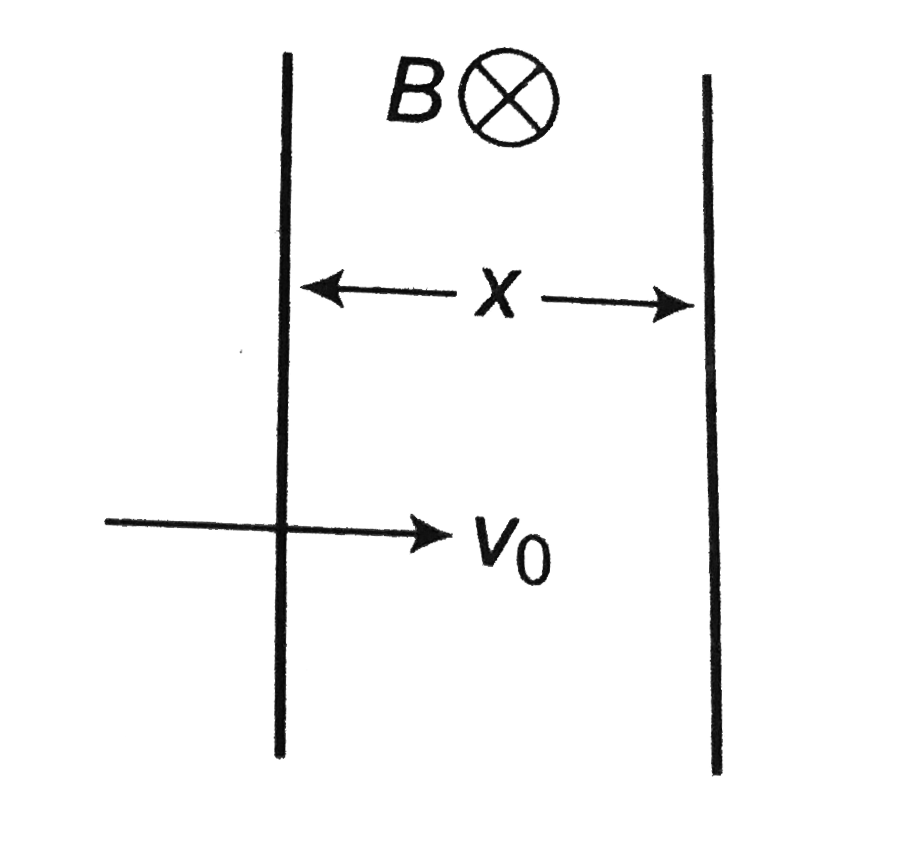A charged particle enters a uniform magnetic field with velocity v0=4m/s perpendicular to it, the length of magnetic field is x=(√32)R, where R is the radius of the circular path of the particle in the field. Find the magnitude of charge in velocity (in m/s) of the particle when it comes out of the field.
The correct Answer is:4
To solve the problem step by step, we need to analyze the motion of a charged particle entering a uniform magnetic field and determine its velocity when it exits the field.
Step 1: Understand the motion of the particle
The charged particle enters a uniform magnetic field with an initial velocity v0=4m/s perpendicular to the field. The particle will follow a circular path due to the magnetic force acting on it.
Step 2: Determine the radius of the circular path
The radius R of the circular path is related to the length of the magnetic field x given by:
x=√32R
This means that the particle will travel a circular arc of length x within the magnetic field.
Step 3: Calculate the angle subtended by the arc
The angle θ subtended by the arc can be calculated using the formula for the length of an arc:
x=Rθ
Substituting the expression for x:
√32R=Rθ⟹θ=√32
However, we need to express this in radians for further calculations. The angle in radians corresponding to √32 is not straightforward, so we will use the relationship between the arc length and the radius to find the angle directly.
Step 4: Calculate the angular displacement
The total angle θ in radians can be calculated as:
θ=xR=√32RR=√32
This angle corresponds to 60∘ or π3 radians.
Step 5: Determine the components of the velocity
When the particle exits the magnetic field, it will have two components of velocity due to the circular motion:
- The radial component vr=v0cos(60∘)=v0⋅12=2m/s
- The tangential component vt=v0sin(60∘)=v0⋅√32=4⋅√32=2√3m/s
Step 6: Calculate the resultant velocity
The resultant velocity vf when the particle exits the magnetic field can be found using the Pythagorean theorem:
vf=√(vr)2+(vt)2=√(2)2+(2√3)2=√4+12=√16=4m/s
Conclusion
The magnitude of the velocity of the particle when it comes out of the field is 4m/s.
The charged particle enters a uniform magnetic field with an initial velocity v0=4m/s perpendicular to the field. The particle will follow a circular path due to the magnetic force acting on it.
The radius R of the circular path is related to the length of the magnetic field x given by:
x=√32R
This means that the particle will travel a circular arc of length x within the magnetic field.
The angle θ subtended by the arc can be calculated using the formula for the length of an arc:
x=Rθ
Substituting the expression for x:
√32R=Rθ⟹θ=√32
However, we need to express this in radians for further calculations. The angle in radians corresponding to √32 is not straightforward, so we will use the relationship between the arc length and the radius to find the angle directly.
The total angle θ in radians can be calculated as:
θ=xR=√32RR=√32
This angle corresponds to 60∘ or π3 radians.
When the particle exits the magnetic field, it will have two components of velocity due to the circular motion:
- The radial component vr=v0cos(60∘)=v0⋅12=2m/s
- The tangential component vt=v0sin(60∘)=v0⋅√32=4⋅√32=2√3m/s
The resultant velocity vf when the particle exits the magnetic field can be found using the Pythagorean theorem:
vf=√(vr)2+(vt)2=√(2)2+(2√3)2=√4+12=√16=4m/s
The magnitude of the velocity of the particle when it comes out of the field is 4m/s.
Topper's Solved these Questions
- BOOK - CENGAGE PHYSICSCHAPTER - MISCELLANEOUS VOLUME 5EXERCISE - Linked Comprehension84videos
MISCELLANEOUS VOLUME 5
- BOOK - CENGAGE PHYSICSCHAPTER - MISCELLANEOUS VOLUME 3EXERCISE - True and False3videos
MISCELLANEOUS VOLUME 3
- BOOK - CENGAGE PHYSICSCHAPTER - Moving charges and magnetismEXERCISE - Question Bank20videos
Moving charges and magnetism
Similar Questions
Knowledge Check
- Question 1 - Select One
A charged particle enters into a uniform magnetic field with velocity v0 perpendicular to it , the length of magnetic field is x=√32R, where R is the radius of the circular path of the particle in the field .The magnitude of change in velocity of the particle when it comes out of the field is
 A2v0Bv0/(2)C√3v02Dv0
A2v0Bv0/(2)C√3v02Dv0 - Question 2 - Select One
When a charged particle enters a uniform magnetic field its kinetic energy
Aremains constantBincreasedCdecreasesDbecomes - Question 3 - Select One
When a charged particle enters a uniform magnetic field its kinetic energy
ARemains constantBIncreasesCDecreasesDBecomes zero
A charged particle enters in a uniform magnetic field with a certain velocity. The power delivered to the particle by the magnetic field depends on
View SolutionA charged particle entering a magnetic field from outside in a direction perpendicular to the field
View SolutionThe path of a charged particle in a uniform magnetic field, when the velocity and the magnetic field are perpendicular to each other is a
View SolutionA charged particle enters a uniform magnetic field with velocity vector at angle of 45∘ with the magnetic field. The pitch of the helical path followed by the particle is p. the radius of the helix will be
View SolutionA charged particle is moving with velocity Vin magnetic field
View Solution

